The Journey of Ice Cream Bars on Wooden Sticks
Despite the fierce patent wars for a few years, ice cream bars have flourished thanks to simple ideas and the powerful will of amazing people who turned those ideas into reality. These popular frozen treats prove that even from the most straightforward concepts, amazing products can emerge and captivate the world.
Ready to hear the long story short? Read on.
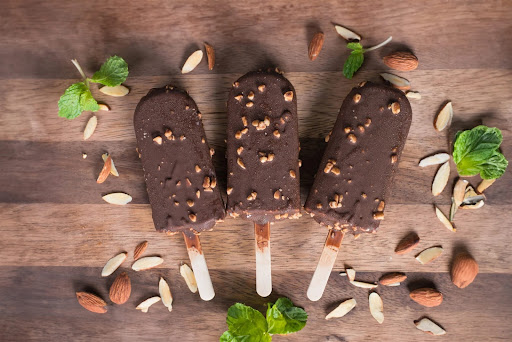 Homemade Chocolate-Coated Ice Cream Bars (Blushlane)
Homemade Chocolate-Coated Ice Cream Bars (Blushlane)
It’s a sunny day somewhere around 1920 in the heart of a bustling town in Iowa, US. There stands a quaint candy store adorned with colourful signage and a delightful aroma that wafts through the air. A young boy named Douglas Ressenden walks into the store to buy ice cream but changes his mind and decides to buy a chocolate bar.
The store’s owner is Christian Kent Nelson, a Danish immigrant, a World War I veteran, and a high school teacher. Nelson, who is witnessing the boy’s indecision between the two, asks him why he doesn’t buy both, and the boy replies: “I want ‘em both, but I only got a nickel!”
The experience makes Nelson wonder if he could create something that can give that boy both the chocolate and the ice cream, something like a chocolate-covered ice cream maybe. Later on, he gives it a try, only to find out that it’s more challenging than he initially thought. So, he spends weeks and consults many others, trying to find the right way to stick melted chocolate to the ice cream.
Thanks to the help of cocoa butter, Nelson finally succeeds, producing a new product he now calls “I-Scream Bars.” The new treat becomes a hit, and the candy shop owner thinks about expanding his product into new markets.
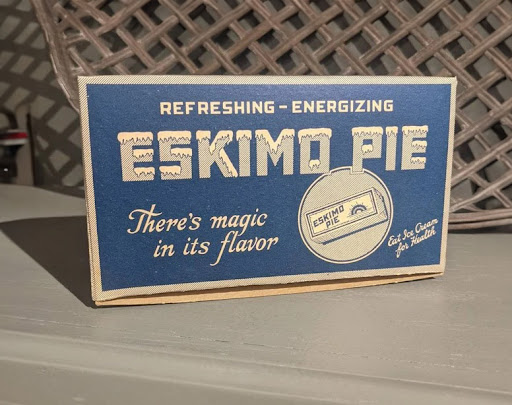 1920’s Eskimo Pie Box Ice Cream Container (Advertising Collector)
1920’s Eskimo Pie Box Ice Cream Container (Advertising Collector)
He partners with chocolate maker Russell C. Stover and the two start taking their product to the national market. Soon, the new treat, now called the “Eskimo Pie,” becomes an instant success. The Eskimo Pie’s popularity soared quickly, with an astonishing 1 million pies sold daily by the spring of 1922.
Ice Cream Bars With a Stick
The evolution of the bars doesn’t stop with the chocolate coating, as it takes an intriguing turn when a Chicago-based confectioner named Harry Burt decides to give this frozen delight a new twist. He introduced the world to chocolate-covered ice cream bars on a stick, an innovation that revolutionizes how we enjoy our favourite frozen treats forever.
The story of the new upgrade is also straightforward. Burt replicates Nelson’s new product, but his 23-year-old daughter Ruth finds it too messy. So, Burt’s son, Harry Jr., suggests using a wooden stick as a convenient handle. They try it out and see the stick forms a strong bond with the ice cream.
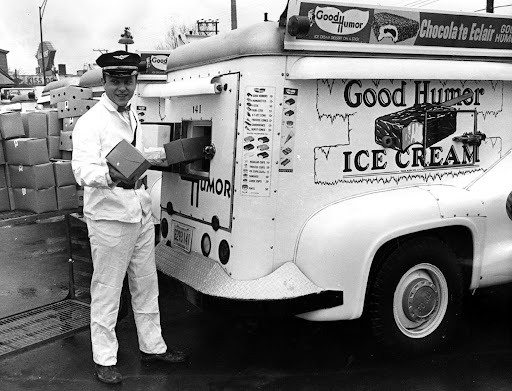 Good Humor Man (Chicago Tribune)
Good Humor Man (Chicago Tribune)
He patents his process and machinery, names his product “Good Humor,” and launches a fleet of refrigerated trucks driven by “Good Humor men” dispensing ice cream directly to neighborhoods nationwide. The company still operates, building a happier neighbourhood one treat at a time.
Ever since, using wooden sticks with ice cream bars has become a standard and practical approach for manufacturers and consumers, providing a convenient and fun way to enjoy frozen treats.
Ice Cream Factory: How Choc Ice is Made (1957) | British Pathé
Popular Bars in Canada
Today, ice cream bars are available year-round in most grocery stores in Canada. Some of the popular manufacturers include:
 Chapman’s Pistachio & Dark Chocolate Bars, Canadian Collection
Chapman’s Pistachio & Dark Chocolate Bars, Canadian Collection
-
Chapman’s: Chapman’s is known for its wide range of products. They offer various flavours, including Super Lolly, Yukon Novelties, Twisters, Vanilla & Milk Chocolate Frozen Yogurt Bar, and no-sugar-added options like Salty Caramel & Peanuts.
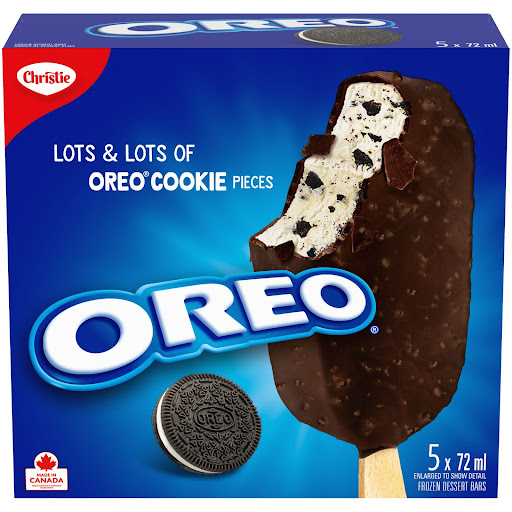 Nestle’s CHRISTIE® OREO Bar
Nestle’s CHRISTIE® OREO Bar
-
Nestlé: Nestlé offers a variety of frozen desserts in Canada, including classics like the Drumstick, Kit Kat, and Oreo bars.
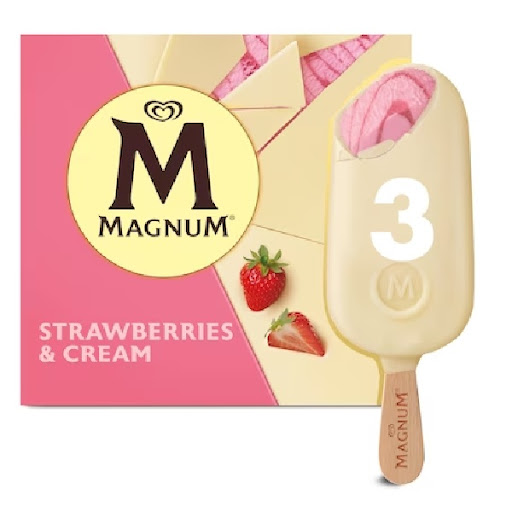 Magnum Classic Strawberries & Cream
Magnum Classic Strawberries & Cream
-
Magnum: Magnum is a well-known brand in the frozen desserts world. They offer a variety of flavours, including Classic, Almond, Double Caramel, and more.
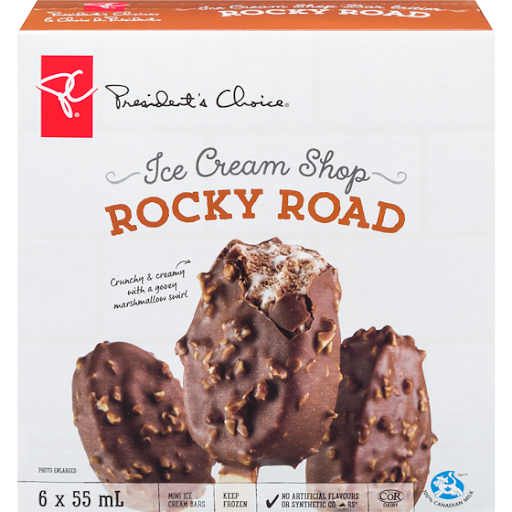 Rocky Road bars by President’s Choice
Rocky Road bars by President’s Choice
-
President’s Choice: President’s Choice is available at Loblaw-owned grocery stores in Canada, such as Loblaws, Provigo, Real Canadian Superstore, Maxi, and No Frills. They offer their Decadent Chocolate Chip Cookie Dough Bars, Loads of Caramel Sundae Bars, Rocky Road, and more.
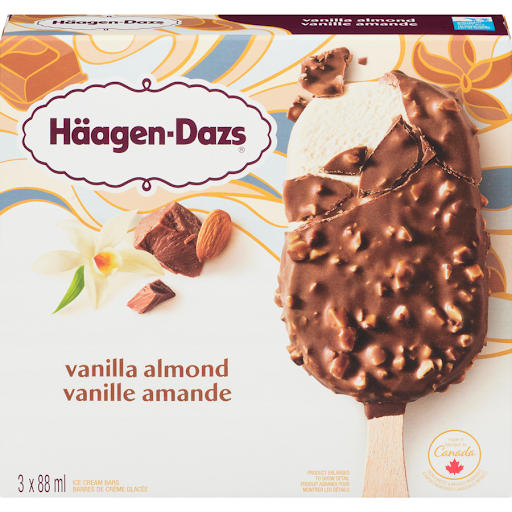 Häagen-Dazs Vanilla Almond
Häagen-Dazs Vanilla Almond
-
Häagen-Dazs: Häagen-Dazs offers indulgent options in Canada with rich flavours and high-quality ingredients, including Häagen Dazs Non-Dairy Bars. Though they’re pricier than other ice creams, they have a loyal fan base.
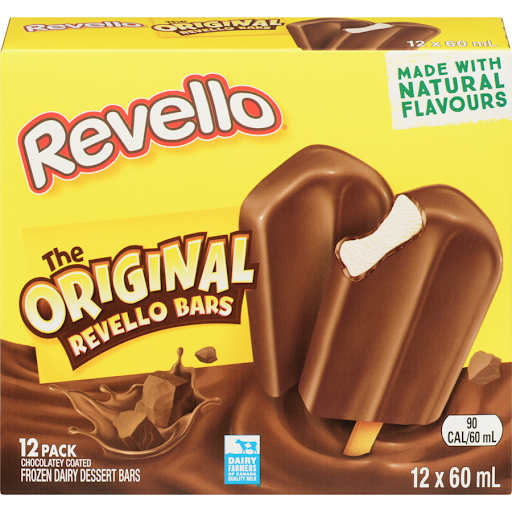 Original Revello Frozen Dairy Dessert Bars
Original Revello Frozen Dairy Dessert Bars
-
Revello: These feature vanilla ice cream coated in chocolate bars. It’s a mix between a popsicle and an ice cream bar.
What Is the Reason Behind Using “Wooden” Sticks?
Some manufacturers are exploring other sustainable options, but wooden sticks continue to be the most widely used option due to several reasons:
- Cost-Effectiveness: Wooden sticks are a relatively inexpensive and cost-effective option for ice cream manufacturers.
- Safety and non-toxicity: Wood is a food-safe material, and wooden sticks are generally considered safe to be in contact with food.
-
Biodegradability: Wooden sticks are biodegradable and more environmentally friendly compared to plastic alternatives.
- Versatility: Wooden sticks can be repurposed after they have been used to serve ice cream for various purposes such as crafting, cooking, or gardening, helping to reduce waste.
- Thermal properties: Wood has better thermal properties for handling ice cream than metal or plastic, which helps reduce the risk of discomfort from the cold.
-
Ease of handling: Wooden sticks are lightweight and comfortable to hold, providing a smooth and natural grip.
- Better Sticking to the Ice Cream: Due to its natural qualities, wood holds ice cream better than plastic, resulting in a better experience.
- Customizability: Wooden sticks can be easily marked with logos, designs, or branding messages, making them an effective marketing tool.
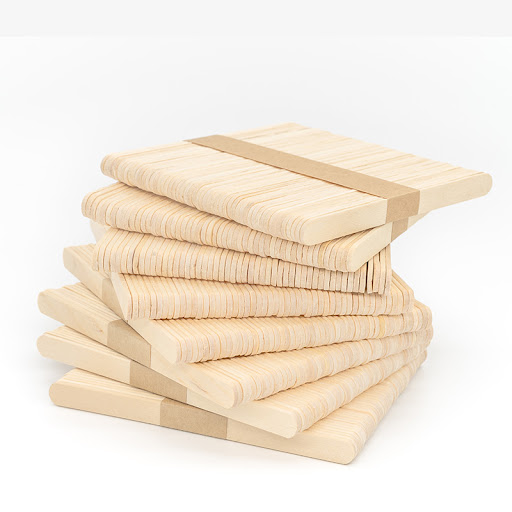 Packs of Ice Cream Wooden Sticks (Vinzorwood)
Packs of Ice Cream Wooden Sticks (Vinzorwood)
How Many Wooden Ice Cream Sticks Are Produced Each Year?
The global production of ice cream sticks is not precisely clear. Still, to give you an idea, Chapman’s, one of Canada’s largest independent ice cream and frozen yogurt manufacturers, says on its website that it uses 300,000,000 ice cream sticks every year, which would be enough to travel the whole circumference of the earth.
If you are curious to know how much birch wood equals how many sticks, according to the president of an ice cream stick manufacturer, an estimated 80,000 to 100,000 cubic meters of birch wood is needed to produce a staggering 8 billion ice cream sticks.
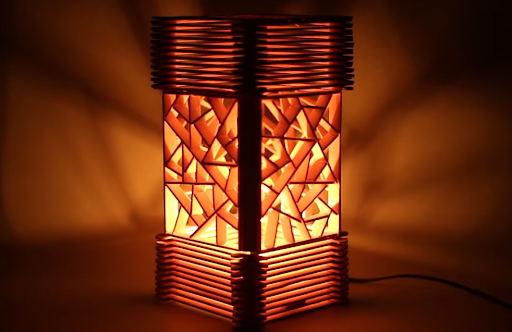 Floor lamp made with repurposed popsicle sticks
Floor lamp made with repurposed popsicle sticks
Are Wooden Sticks Recyclable?
With the increasing demand for sustainable products and the finite nature of natural resources, it is important to consider whether or not ice cream sticks can be recycled. Most of the time, these sticks are usually discarded in the trash when they are no longer needed. In this case, they probably will not get recycled because they are small, thin, and contaminated with food or other substances. Some specific facilities may be able to recycle them along with other types of wood, but generally, they are not recyclable.
However, there are a few options for disposing of popsicle sticks in a more environmentally responsible way:
- Turning them into compost: Wooden sticks can be placed in a compost bin along with other organic materials. They will break down over time and enrich the soil.
Popsicle Stick Hanging Lamp (Dyartorin Crafts)
- Repurposing: After adequately washing, popsicle sticks can be repurposed and used for creating crafts or other projects, such as building a birdhouse, creating a mosaic, or making a flowerpot. This can help extend their lifespan, reduce waste, and help preserve natural resources.
Our journey through the world of ice cream bars and their wooden sticks has been nothing short of delightful, a duo that has created moments of pure joy and happiness for countless people. We’ve seen how this frozen treat has evolved based on simple ideas and continues to evolve. So, the next time you reach for one, remember the fascinating journey it has taken to get to your hands and appreciate the sustainable practices that can help us responsibly dispose of the wooden sticks.




